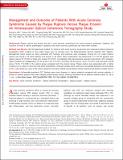Management and Outcome of Patients With Acute Coronary Syndrome Caused by Plaque Rupture Versus Plaque Erosion: An Intravascular Optical Coherence Tomography Study
Author(s)
Hu, Sining; Zhu, Yinchun; Zhang, Yingying; Dai, Jiannan; Li, Lulu; Dauerman, Harold; Soeda, Tsunenari; Wang, Zhao; Lee, Hang; Wang, Chao; Zhe, Chunyang; Wang, Yan; Zheng, Gonghui; Zhang, Shaosong; Jia, Haibo; Yu, Bo; Jang, Ik‐Kyung; ... Show more Show less
Downloade004730.full.pdf (1.463Mb)
PUBLISHER_CC
Publisher with Creative Commons License
Creative Commons Attribution
Terms of use
Metadata
Show full item recordAbstract
Background-Plaque rupture and erosion are the 2 most common mechanisms for acute coronary syndromes. However, the outcome of these 2 distinct pathologies in patients with acute coronary syndromes has never been studied. Methods and Results-We retrospectively studied 141 patients with acute coronary syndromes who underwent optical coherence tomography (OCT) imaging of the culprit lesion prior to stenting from the Massachusetts General Hospital OCT Registry. Management (stent versus no stent), poststent OCT findings, and outcomes were compared. Among the 141 culprit lesions, rupture was found in 79 (56%) patients and erosion in 62 (44%). Stent implantation was performed in 77 (97.5%) patients with rupture versus 49 (79.0%) in those with erosion (P < 0.001). Immediately after percutaneous coronary intervention, OCT showed a higher incidence of malapposition (37.5% versus 7.3%, P < 0.001), thrombus (59.4% versus 14.6%, P < 0.001), and protrusion (93.8% versus 73.2%, P = 0.008) in the rupture group compared with the erosion group. Plaque rupture was associated with a higher incidence of no reflow or slow flow and distal embolization. Although cardiac event rates were comparable between the two groups at the 1-year follow-up, none of the erosion patients who were treated conservatively without stenting had adverse cardiac events. Conclusions-Unfavorable poststent OCT findings were more frequent in rupture patients compared with erosion patients. A subset of erosion patients who were treated conservatively without stenting remained free of adverse cardiac events for up to 1 year. Keywords: acute coronary syndrome; optical coherence tomography; plaque erosion; plaque rupture
Date issued
2017-02Department
Massachusetts Institute of Technology. Department of Electrical Engineering and Computer ScienceJournal
Journal of the American Heart Association
Publisher
American Heart Association
Citation
Hu, Sining et al. “Management and Outcome of Patients With Acute Coronary Syndrome Caused by Plaque Rupture Versus Plaque Erosion: An Intravascular Optical Coherence Tomography Study.” Journal of the American Heart Association 6, 3 (February 2017): e004730 © 2017 The Authors
Version: Final published version
ISSN
2047-9980